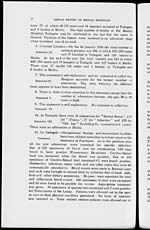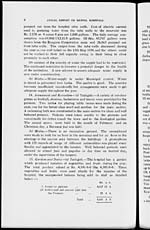Medicine - Mental health > 1925-1940 - Note on the mental hospitals in Burma > Annual report on mental hospitals in Burma for the year 1936
(413) Page 3
Download files
Individual page:
Thumbnail gallery: Grid view | List view

IN BURMA FOR THE YEAR 1936. 3
the open with attendants and it was found that this method was more
effective in making them quieter. Continuous hot baths were given for
restless patients and Paraldehyde is the most common soporific used.
As far as possible, acute recoverable cases were kept apart from the
chronic patients. Cases of General Paralysis of the Insane were
treated by means of pyrexial treatment induced by means of intravenous
injections of T.A.B. vaccine followed by injections of Tryparsamide,
mercurials and Bismuth.
Induction of Pyrexia by means of inoculation of malarial blood had
to be abandoned on account of the risk of cerebral malaria, due to
mixture of M.T. Malaria in the donor or sometimes of a recrudescence
of M.T. Malaria in the patient himself.
(b) Minbu.—No specific therapeutic treatment was given.
Dietetic and occupational treatment to promote mental and physical
health of the inmates were given. Germinating grains and pulses and
aromatic herbs were supplied for the last three months to all the
inmates. Rouwolfea Serpentina was tried during the year on the case
which developed Nephritis last year and also on two other cases with
favourable result.
12. Sanitation and Conservancy—(a) Tadagale.—The water-borne
system for the disposal of sewage continued to work satisfactorily. The
buildings, compound and out-houses were kept thoroughly clean by
the patients. Covered dust bins were provided in suitable places and
chloride of lime sprinkled round. The clothing was periodically
disinfected by means of the thresh disinfector.
(b) Minbu.—The precints were kept clean and tidy. The
drains were flushed with water and sprayed with cresol lotion daily.
The latrine (bucket system) has nine seats. The buckets were emptied
four times daily by the hospital sweepers into fifth receptacles, provided
with tight covers and kept outside the compound. These were emptied
daily into Municipal night soil carts. The dormitories and hospital
are also provided with night latrines of bucket system. The buckets
and receptacles were kept clean.
Clothing was washed and changed once in three days and disinfected
and sterilized. Bedding including cots were dried in the sun and aired
daily by turns. Bugs were very few and those present were destroyed
as far as possible.
13. Water-supply—(a) Tadagale.—The total consumption of water
for drinking and other requirements during the year was 25,550,500
gallons (excluding separate garden water supply) costing Rs. 10,583-10-0
(Rs. 10,038-11-0). Of this, 16,011,380 gallons were obtained from the
Corporation main at 8 annas per 1000 gallons while 9,539,120 were
Set display mode to: Large image | Zoom image | Transcription
Images and transcriptions on this page, including medium image downloads, may be used under the Creative Commons Attribution 4.0 International Licence unless otherwise stated. ![]()
| India Papers > Medicine - Mental health > Note on the mental hospitals in Burma > Annual report on mental hospitals in Burma for the year 1936 > (413) Page 3 |
|---|
| Permanent URL | https://digital.nls.uk/83983220 |
|---|




